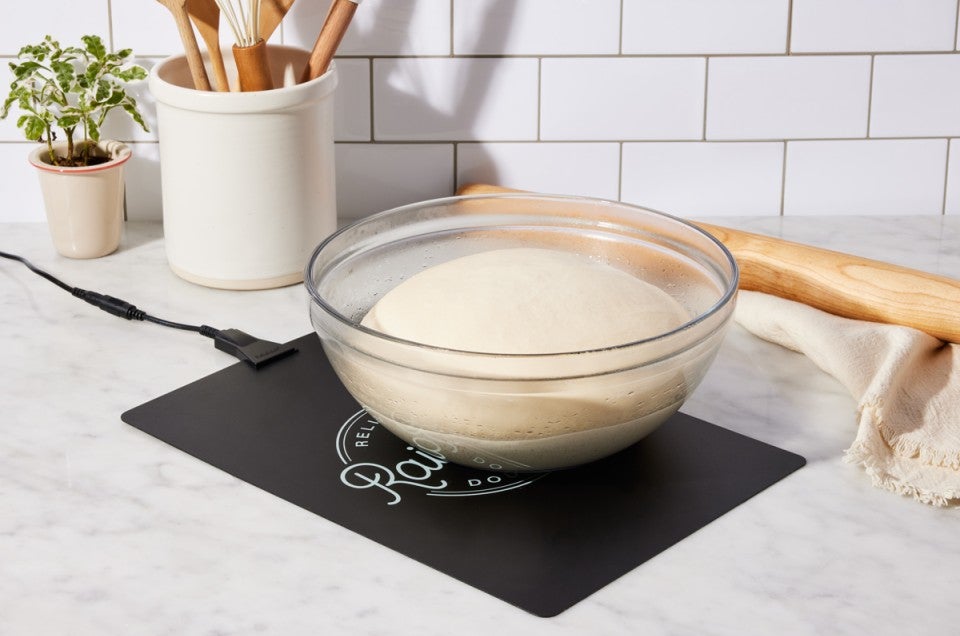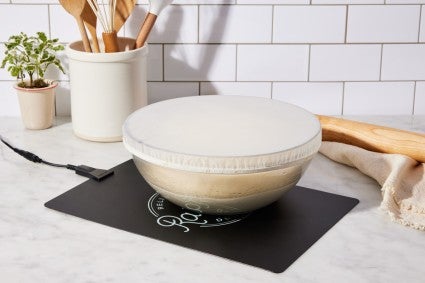This electric blanket for bread makes dough rise bigger, faster, and better
For last-minute bakers and chilly homes, it's a game changer.


In my years-long quest to be a weeknight pizza maker, I should have had no hindrances. Fast pizza recipes exist (here’s one now), as does the perfect flour. And the necessary tools? I have them all. The thing I lacked was foresight. The pang to make pizza for dinner never seemed to hit me until 3 p.m., at which point I knew it was too late: In a house as cold as mine, pizza dough would never rise in time for dinner. It would maybe, maybe, be ready for a midnight snack.
Like me, doughs thrive in warm, comfortable conditions (around 72°F to 78°F); and like me, they become sluggish when they have to hang out in rooms that are cooler. In my perpetually freezing house (somehow always cold, no matter the season), bread doughs rise at a snail’s pace, making the listed proofing time in recipes all but irrelevant. That’s not just inconvenient; poorly proofed doughs will have a denser crumb, a mediocre shape, and simply won’t be as light and fluffy.
The solution (for my doughs, anyway) has always been obvious: I needed to create the warm and hopefully steamy conditions that doughs rise best in. I tried hacks like proofing my doughs in an oven with the pilot light on, or in bowls that I wrapped with wool sweaters, but those tricks never worked for me. What I needed was a dough proofer. Long a solution in professional bakeries, proofers — which create the warm, steamy conditions I was chasing — have been available to home bakers for a while now; this one from Brod & Taylor is well-loved by many of my co-workers. I never bought it, because in addition to being cold, my apartment is also small, and I didn’t know where I would store such a thing. But when King Arthur brought in another dough proofer, this one thinner than a cookie sheet, my excuses were nullified and my interest was piqued. I bought one immediately.

The XL Raisenne Dough Proofer is a paper-thin, 14" by 10" pad that heats to 85°F. Any bowl or pan can be placed on top of it to take advantage of its steady flow of gentle heat. If your dough is covered (not with a towel!) that heat eventually gets trapped in the bowl, creating optimal conditions for the dough to rise quickly. That’s what I was told, anyway. To find out if it worked, I put it to the pizza test.
I picked a relatively fast recipe: Pick-Your-Pan Pizza, which start-to-finish takes four hours. I started it at 3 p.m. In my previous life, that would have been a laughable time — the dough would have taken close to double the amount of time listed to complete its various risings. But as I placed the bowl of dough on the Raisenne, I held on to hope that maybe, this time, my pizza would be ready before I went to bed.
The Raisenne can be put on any surface, so I was able to put my dough right on my desk. I took meetings and typed out emails as the Raisenne, which heated up quickly, warmed my dough from the bottom up. Several times I reached out to touch the Raisenne; as advertised, it was warm and steady, never advancing to anything you’d call hot. (In this way it is different from a heating pad, which offers less consistent heat and, besides, would be awkward to rest a bowl of dough on.) The warmth was very pleasant, and more than once I wished I could put the Raisenne in my lap and have it warm me like an electric blanket.
And that’s not such a crazy thought: The Raisenne is essentially an electric blanket for yeasted doughs. It kept my pizza dough very cozy, and in turn the dough rose robustly. I’ve made Pick-Your-Pan-Pizza many times and I can say with certainty that it has never risen as quickly or vigorously as it did on top of the Raisenne.
In fact, the dough was fully proofed 15 minutes earlier than the recipe suggested it would be. This is an outcome that the makers of Raisenne acknowledge may happen (on their site they mention that proofing times could be cut by as much as half), and while hardly a flaw, it is something to watch out for. Doughs that proof with the aid of a Raisenne should be assessed frequently. And while there’s absolutely no concern when it comes to doughs like that pizza dough and your typical sandwich loaves, breads that rely on a long, slow rise for flavor (see: Pain de Campagne, etc.) may be better off proofing without aid.

But my pizza? I pulled it out of the oven at 7 p.m. — perfectly timed for dinner — and it was taller, airier, and had a crispier crust than I’d ever previously achieved. So I’m keeping my Raisenne. I’ll store it with my sheet pans, where it’s so slender I’ll barely notice it, and wait for 3 p.m. pizza inspiration to strike again. When it does, I won’t hesitate. Thanks to the Raisenne, I’ll never say no to pizza again.

Cover photo by Rick Holbrook; food styling by Kaitlin Wayne.



December 25, 2023 at 2:04pm
I would like to proof artisan dutch oven breads at 72-75 degrees. Can I use this heater, place a cooling rack over it to raise my dough tub off the surface and thus achieve less warming of the dough?
December 30, 2023 at 2:33pm
In reply to I would like to proof… by Richard (not verified)
Hi Richard! While you certainly could place your container on a rack over the heating pad, most of that heat may escape around the tub instead. Since you are wanting to proof at a specific temperature, we may suggest looking into a proofing box such as this. You can control the exact temperature that is reached with these. Happy Baking!
December 2, 2023 at 7:45pm
Can I put my King A proofing bucket on it? Or does it get too hot?
December 5, 2023 at 12:39pm
In reply to Can I put my King A proofing… by Lori Berhon (not verified)
Hi Lori, the Raisenne Dough Riser only heats up to 85°F, so your proofing bucket will be fine.
October 8, 2023 at 7:23pm
Could you use this to proof your cinnamon rolls for the final proof before you bake?
October 10, 2023 at 1:21pm
In reply to Could you use this to proof… by Rhonda Murphy (not verified)
Hi Rhonda, yes, that should work fine. Just be sure to cover the cinnamon rolls with sprayed plastic wrap so they don't dry out, and keep an eye on them, as they may rise a little faster than you expect at this temperature.
October 8, 2023 at 12:41pm
I use my airfryer on the proof setting, works like a charm!
October 8, 2023 at 11:53am
My bread doughs are set on top of my gas stove, over the pilot light of the grill. Dough rises rather rapidly from the warmth.
October 4, 2023 at 11:55pm
This looks great for yeasted doughs! Could it be used for keeping sourdough starter warm while rising?
October 8, 2023 at 1:09pm
In reply to This looks great for yeasted… by Emma (not verified)
Hi Emma, it's a little warmer than I would normally keep my fully developed sourdough starter, which generally does fine at cooler room temperatures (68-70°F), but if you need your starter to ferment a little faster, it could certainly be used to speed up the ripening process.
Pagination